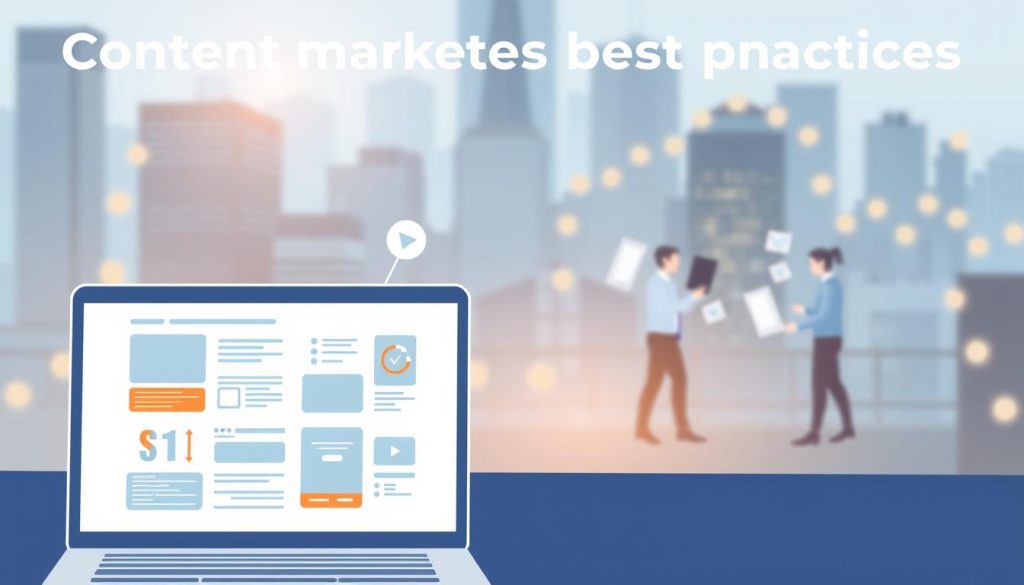In today’s digital landscape, effective content marketing is crucial for driving measurable business growth. We help ambitious business leaders understand how to leverage content marketing strategies that deliver real results.
Our comprehensive guide covers proven content marketing best practices that help you develop compelling content, measure ROI, and optimize your strategy for sustainable growth.
By combining cutting-edge trends with timeless principles, we provide actionable tactics to build a content marketing foundation that drives business success.
Key Takeaways
- Develop a clear content marketing strategy that aligns with your business goals.
- Use compelling content to resonate with your target audience and drive conversions.
- Measure and optimize your content marketing ROI for sustainable growth.
- Stay up-to-date with the latest content marketing trends and best practices.
- Build a strong brand identity through consistent and high-quality content.
The Strategic Value of Content Marketing in 2024
As we navigate 2024, it’s clear that content marketing is no longer just a marketing tactic, but a critical driver of business growth. The digital landscape demands that brands connect with their audience in ways that feel both organic and intentional. Content marketing provides this opportunity, serving as a strategic approach to creating and distributing valuable, relevant content to attract and engage a clearly defined audience.
Defining Content Marketing and Its Business Impact
Content marketing is the process of creating, developing, producing, sharing, and distributing content to a target audience. It’s about telling your brand’s story in a way that resonates with customers and drives conversions. By adopting a robust content marketing strategy, businesses can differentiate themselves from competitors and establish a meaningful connection with their audience.
Research by CMI has shown that content marketing generates three times as many leads as traditional outbound marketing but costs 62% less. This significant return on investment (ROI) underscores the value of incorporating content marketing into a business strategy.
How Content Marketing Drives Business Growth
Effective content marketing drives business growth by building trust, establishing authority, and creating meaningful connections with the target audience. It supports the entire customer journey, from awareness through consideration to purchase and beyond. By leveraging content marketing, businesses can improve key metrics such as lead generation, conversion rates, and customer retention, ultimately contributing to sustainable growth.
Moreover, a well-executed content marketing strategy enables businesses to stay ahead of competitors who fail to leverage content effectively. It’s a critical component of a comprehensive business strategy, offering a superior ROI compared to traditional marketing approaches.
Developing an Effective Content Marketing Strategy
To make content marketing work for your business, you need a well-thought-out strategy. This involves taking the time to brainstorm and carefully consider what you want to achieve through your content marketing efforts.
Setting Clear, Achievable Goals
During your brainstorming and content ideation processes, it’s crucial to develop achievable goals. Examples of content marketing goals include improving revenue, generating great leads, increasing conversions, and boosting brand awareness and authority within your industry’s niche.
Creating a Comprehensive Editorial Calendar
A well-planned editorial calendar ensures consistent content production without sacrificing quality. It helps in organizing content in advance, aligning it with business objectives, and making adjustments as needed.
Aligning Content with Business Objectives
Your content strategy should align with broader business goals like revenue growth, lead generation, and brand authority. This involves creating a framework that ties your content creation to measurable business outcomes.
By following these steps and maintaining a focus on your audience and business needs, you can develop a content marketing strategy that drives real results.
Understanding Your Target Audience
A profound understanding of your target audience is essential for crafting content that meets their needs and expectations. To achieve this, we need to delve into their motivations, behaviors, challenges, and goals. By doing so, we can create empathetic content marketing campaigns that resonate with our audience on a deeper level.
Creating Detailed Buyer Personas
Creating detailed buyer personas is a crucial step in understanding our target audience. This involves going beyond basic demographics to capture their motivations, pain points, and decision triggers. By conducting thorough audience research, we can develop a nuanced understanding of our audience, enabling us to craft content that speaks directly to their needs. Effective buyer personas help us tailor our content marketing strategy to address the specific challenges and aspirations of our audience.
Mapping the Customer Journey
Mapping the customer journey is another vital aspect of understanding our target audience. This process involves tracking the path our buyers take, from initial awareness to becoming brand ambassadors. The customer journey typically follows stages such as Awareness, Consideration, Purchase, Retention, and Advocacy. By understanding these stages, we can identify critical content opportunities and develop targeted content that addresses the specific needs of our audience at each stage, ultimately driving them towards a purchase and beyond.
Content Marketing Best Practices for Creating Compelling Content
To stand out in a crowded digital landscape, businesses must adopt content marketing best practices that drive engagement and conversion. Creating compelling content is crucial for capturing the audience’s attention and building brand loyalty.

Prioritizing Quality Over Quantity
Prioritizing quality over quantity is essential for building trust and driving meaningful engagement. By focusing on creating high-quality, relevant content, businesses can establish themselves as authorities in their industry. This approach not only enhances brand reputation but also fosters a loyal audience.
High-quality content is characterized by its ability to provide value to the audience, whether through educating, entertaining, or inspiring. It’s about creating a connection with the audience that goes beyond mere promotional messaging.
Providing Value to Your Audience
Delivering value to your audience is paramount in content marketing. This can be achieved by educating your audience through various content formats such as blogs, infographics, podcasts, and interviews. The key is to address the audience’s most pressing questions and challenges directly.
By doing so, businesses can position themselves as curators of knowledge, building trust and establishing a strong brand identity. As noted by industry experts, “Creating story-driven content tends to perform better than authoritative content by positioning yourself as a curator of knowledge.”
Maintaining Brand Voice and Consistency
Maintaining a consistent brand voice across all content formats and channels is crucial for reinforcing brand identity. This involves developing a clear brand tone and language that resonates with the target audience.
Consistency in branding helps to build recognition and reinforces the brand’s message, making it more likely to be remembered by the audience. As part of a broader content strategy, maintaining brand voice and consistency is key to creating a cohesive brand experience.
Conducting a Content Audit
Conducting a thorough content audit is crucial for understanding the effectiveness of your current content marketing strategy. Before creating new content, it’s essential to assess what’s already working and what areas need improvement.
As noted by industry experts, “A content audit doesn’t have to be too challenging to complete, and chances are, you’ll already have a good idea of what is working for your brand and what is not.” This insight underscores the importance of taking stock of your existing content to inform future marketing decisions.
Evaluating Existing Content Performance
To evaluate existing content performance, we need to examine key metrics that align with our business objectives. This involves analyzing metrics such as engagement rates, page views, and conversion rates to determine which pieces of content are driving results and which are underperforming.
By leveraging tools and analytics, we can gain a deeper understanding of our content’s performance over time. For instance, “75% of the companies semRush surveyed are conducting a content audit once a year,” indicating a growing recognition of the importance of regular content evaluation.
Identifying Content Gaps and Opportunities
Identifying content gaps and opportunities is a critical step in refining our content marketing strategy. By analyzing our existing content library, we can pinpoint areas where our content is lacking or underperforming, and identify opportunities to create new content that resonates with our audience.
This process enables us to prioritize our content creation efforts, focusing on topics and formats that are likely to drive the best results. As we move forward, we’ll be able to use our content audit findings to inform our future content strategy and maximize our marketing impact.
Essential Content Types for a Balanced Strategy
In 2024, a balanced content marketing strategy will rely on a variety of content formats to captivate your target audience. Diversifying your content strategy means creating different kinds of content and expanding the types of topics and themes covered in previous assets. This approach helps keep your audience engaged and interested in your brand.
Blog Posts and Long-Form Content
Blog posts remain a cornerstone of content marketing, helping businesses rank in search engines for relevant keywords. Long-form content, such as whitepapers and eBooks, provides in-depth information and establishes thought leadership. These content types are crucial for SEO performance and building trust with your audience.
- Improve search engine rankings
- Establish thought leadership
- Provide detailed information on complex topics
Video Content and Podcasts
Video content is becoming increasingly popular in both B2B and B2C marketing strategies. It’s easier than ever to produce high-quality video content using smartphones. Video and podcasts help build deeper connections with your audience through visual and audio engagement, making your brand more relatable and trustworthy.
- Enhance audience engagement
- Build trust through visual and auditory cues
- Diversify your content offerings

Social Media Content
Social media content is vital for driving engagement and maintaining brand consistency across platforms. By creating content tailored to each social media channel, you can increase your brand’s visibility and interact with your audience in real-time.
- Boost engagement on social media platforms
- Maintain brand consistency
- Interact with your audience in real-time
Email Marketing Content
Email marketing content nurtures leads and strengthens customer relationships by providing value through newsletters, promotional emails, and personalized messages. Effective email marketing content is tailored to the recipient’s interests and needs, enhancing the overall customer experience.
- Nurture leads through targeted content
- Strengthen customer relationships
- Enhance customer experience through personalization
By incorporating these essential content types into your strategy, you can create a balanced and effective content marketing approach that resonates with your audience and drives business growth.
Balancing Evergreen and Topical Content
The key to a robust content marketing strategy lies in effectively balancing evergreen content with timely, trending topics. This balance is crucial for maintaining a dynamic content mix that addresses both the long-term needs of your audience and the short-term interests driven by current events or trends.
Creating Lasting Evergreen Content
Evergreen content remains relevant over time, continuing to attract and provide value to your audience long after its initial publication. Examples include listicles, “tips and tricks” articles, and informational how-to guides. To create effective evergreen content, focus on topics that are consistently relevant to your audience’s pain points and questions. Regularly updating and refreshing this content can help maintain its relevance and improve its search performance.
| Evergreen Content Type | Description | Benefits |
|---|---|---|
| Listicles | Articles presented in a list format | Easy to consume, shareable |
| How-to Guides | Detailed instructional content | Provides value, establishes authority |
| “Tips and Tricks” Articles | Content offering advice and insights | Engaging, informative |
Leveraging Timely, Trending Topics
Incorporating topical content into your marketing strategy allows you to capitalize on current trends and interests, boosting short-term visibility and engagement. To effectively leverage trending topics, stay informed about industry news and developments. Curate content from credible sources or share expert insights to keep your audience ahead of the curve. Combining evergreen and topical content creates a balanced content marketing approach that supports both long-term goals and short-term opportunities.
Content Personalization Strategies
The key to unlocking meaningful connections with your audience lies in effective content personalization strategies. In 2024, understanding your audience is more crucial than ever, and content personalization is at the forefront of this understanding. By tailoring your content to meet the specific needs and preferences of your audience, you can significantly enhance engagement and drive conversions.
Segmenting Your Audience
To personalize content effectively, you first need to segment your audience. This involves creating detailed buyer personas based on demographics, behaviors, and preferences. By understanding the different segments within your audience, you can develop targeted content that resonates with each group. For instance, a younger demographic might prefer video content, while an older demographic might engage more with written articles.
- Identify key demographics and behaviors
- Create detailed buyer personas
- Map content to different stages of the buyer journey
Delivering Tailored Content Experiences
Once you have segmented your audience, the next step is to deliver tailored content experiences. This can be achieved through various technologies and tools that enable personalization across multiple channels. For example, using marketing automation platforms, you can create personalized email campaigns based on user behavior. Additionally, leveraging data analytics can help you understand user preferences and tailor your content accordingly.
Key strategies include:
- Utilizing marketing automation for personalized campaigns
- Leveraging data analytics to understand user preferences
- Creating content that is adaptable across different channels

By implementing these content personalization strategies, businesses can create a more engaging and relevant experience for their audience, ultimately driving better results.
Optimizing Content for Search Engines
As we navigate the complexities of content marketing in 2024, it’s clear that search engine optimization (SEO) continues to play a pivotal role in driving business growth. Every piece of content created can serve multiple purposes, but to reach beyond existing customers, optimizing for search engines is crucial.
Keyword Research and Implementation
Effective SEO begins with thorough keyword research, identifying high-value search terms your target audience uses. Tools like Google Analytics can provide insights into your website’s performance and help refine your keyword strategy. We must implement these keywords naturally into our content to enhance readability and user experience.
To achieve this, we:
- Identify relevant keywords that align with our content and audience
- Use keyword research tools to analyze search volume and competition
- Integrate keywords seamlessly into our content, avoiding keyword stuffing
Technical SEO for Content Marketing
Technical SEO is equally important, as it ensures that search engines can crawl, index, and present our website’s information effectively. With algorithms changing rapidly, maintaining a technically sound website is vital to preserving SEO momentum.
Key technical SEO elements include:
- Ensuring website mobility and responsiveness
- Optimizing page loading speed
- Implementing secure protocols (HTTPS)
By focusing on both keyword research and technical SEO, we can create a robust content marketing strategy that satisfies both search engines and human readers, ultimately driving more traffic to our site.
Content Distribution and Promotion Tactics
Content creation is just the beginning; a robust distribution and promotion plan is necessary to achieve your marketing goals. Without an effective strategy, even the best content can fail to reach its intended audience.
Multichannel Distribution Approach
A multichannel distribution approach is crucial for maximizing content visibility. This involves using various channels such as social media, email marketing, industry publications, and your company website to reach different segments of your audience. By diversifying your distribution channels, you can ensure that your content is seen by a wider audience, thereby increasing its impact.
Consider the following channels for your content distribution:
- Social media platforms like Facebook, Instagram, and LinkedIn
- Email newsletters and marketing campaigns
- Industry-specific publications and websites
- Your company website and blog
Paid vs. Organic Content Promotion
When it comes to promoting your content, you have two primary options: paid and organic promotion. Paid promotion involves using paid advertising channels like social media ads, Google AdWords, and sponsored content to reach a larger audience quickly. On the other hand, organic promotion relies on natural methods such as SEO, social media engagement, and word-of-mouth to build traction over time.
| Promotion Type | Characteristics | Benefits |
|---|---|---|
| Paid Promotion | Quick reach, targeted advertising | Immediate visibility, measurable ROI |
| Organic Promotion | Natural, long-term growth | Sustainable traffic, cost-effective |

Measuring Content Marketing ROI
Measuring the return on investment (ROI) of content marketing is crucial for understanding its impact on business growth. As a long-term strategy, content marketing doesn’t always yield immediate results, making it essential to track the right metrics to gauge its effectiveness.
Key Performance Indicators to Track
To measure content marketing ROI effectively, businesses need to track key performance indicators (KPIs) that align with their marketing objectives. Some early indicators of successful content marketing include higher quality leads, increased brand awareness (through social media mentions, backlinks, and brand queries), and improved website traffic. Tracking specific campaigns is also crucial to understand what content types perform best and should be replicated.
Most marketers rely on tools like Google Analytics, SEMrush, or Ahrefs to measure these metrics. By monitoring these KPIs, businesses can assess the performance of their content marketing efforts and make data-driven decisions.
Using Analytics to Optimize Content Strategy
Analytics play a vital role in optimizing content marketing strategy. By analyzing data, businesses can identify their highest-performing content and understand why it succeeds. This insight allows for the continuous optimization of the content strategy, ensuring that it remains effective and aligned with business objectives.
Using analytics to inform content decisions enables businesses to attribute revenue and business outcomes to their content marketing efforts, demonstrating clear business value to stakeholders. This data-driven approach helps in presenting results in a way that justifies marketing expenditures and supports future marketing investments.
Content Repurposing and Refreshing Strategies
Maximizing ROI from content investments requires strategic repurposing and refreshing. We understand that creating new content constantly can be resource-intensive. Therefore, repurposing existing content is an efficient way to save time and resources while driving traffic to your brand.
Repurposing content involves reusing assets and content pieces in new formats across different channels. This can include transforming blog posts into podcasts, turning interviews into ebooks, or repurposing content with a copyright license. By doing so, you can breathe new life into existing content and reach a wider audience.
Extending Content Lifespan Through Repurposing
To extend the lifespan of your content, identify high-performing blog posts and content that can be repurposed. We recommend transforming these pieces into various formats such as video, audio, or social media content. For instance, a well-performing blog post can be turned into a video script or an infographic, thereby increasing its reach and engagement.
- Identify evergreen content that remains relevant over time.
- Transform content into multiple formats to cater to different audience preferences.
- Utilize content licensing to repurpose successful content efficiently.
Updating Existing Content for Better Performance
Refreshing older content is another effective strategy to improve its search performance and relevance. By updating statistics, reoptimizing keywords, and enhancing the overall quality, you can make your existing content more competitive. This approach not only saves resources but also improves your content’s visibility in search results.
To measure the performance of repurposed and refreshed content, track key metrics such as engagement rates, traffic, and conversion rates. This will help refine your content marketing strategy and ensure that your efforts are yielding the desired results.

Building and Managing a Content Marketing Team
In the ever-evolving landscape of digital marketing, a well-structured content team is the backbone of any successful strategy. As businesses continue to recognize the importance of content in driving growth, the demand for skilled content marketing professionals is on the rise.
Key Roles and Responsibilities
Building a high-performing content marketing team requires identifying the right mix of skills. Essential roles include graphic designers, video producers, SEO specialists, copywriters, and social media managers. A versatile team can handle various content types, from blog posts and long-form content to webinars and social media posts.
| Role | Responsibilities |
|---|---|
| Graphic Designer | Creating visual elements for content |
| SEO Specialist | Optimizing content for search engines |
| Copywriter | Crafting compelling content |
In-house Creation vs. Outsourcing Content
Deciding whether to keep content creation in-house or outsource it is crucial. 57% of successful companies outsource at least some of their content efforts, indicating that a hybrid approach can be effective. Outsourcing can save time and bring in fresh perspectives, while in-house creation maintains brand consistency.
By understanding the strengths of both approaches, businesses can make informed decisions about their content marketing strategy, ensuring they maximize their online presence while maintaining brand integrity.
Combating Misinformation in Content Marketing
As trust in media continues to decline, content marketers must prioritize accuracy to combat misinformation. The healthcare industry is particularly vulnerable to the effects of misinformation, as seen during the COVID-19 pandemic when misinformation led to dangerous practices such as rinsing noses with saline and garlic. With 36% of patients distrusting pharmaceutical companies, it’s clear that building trust through accurate content is crucial.
Building Trust Through Accurate Content
To build trust, content marketers must focus on creating accurate and credible content. This involves providing valuable information that resonates with the target audience. By doing so, brands can establish themselves as trusted authorities in their industry. We’ll explore practical approaches to achieving this goal, including the importance of research in creating high-quality content.
By prioritizing accuracy and credibility, content marketers can combat misinformation and foster a loyal audience. This, in turn, can lead to increased brand loyalty and ultimately drive business growth.
Fact-Checking and Source Verification
Effective fact-checking and source verification are essential components of creating accurate content. This involves verifying information through reputable sources and ensuring that data is up-to-date. By implementing robust fact-checking protocols, content marketers can protect their brand reputation and maintain the trust of their audience. We’ll discuss frameworks for source verification and provide actionable strategies for addressing industry misconceptions through authoritative content.

By adopting these strategies, content marketers can differentiate their content in a crowded marketplace and establish their brand as a trusted information source. This is particularly important in industries where misinformation can have serious consequences.
Content Marketing Trends for 2024
As we dive into 2024, the landscape of content marketing continues to evolve, bringing new trends that businesses must adopt to stay ahead. The coming year will be marked by significant advancements in technology and shifts in consumer behavior, making it crucial for businesses to stay informed and adapt their strategies accordingly.
The Rise of AI in Content Creation
The integration of AI and automation in content creation is transforming the way businesses produce and distribute content. AI tools can help with content generation, optimization, and personalization, allowing marketers to focus on strategy and creativity. By leveraging AI, businesses can enhance their content’s quality and relevance, leading to better engagement and conversion rates.
Growth of Video and Interactive Content
Video content continues to grow in importance, offering businesses a powerful medium to tell their stories and connect with their audiences. High-quality video content can convey complex messages in an engaging and accessible way. Moreover, interactive content, such as quizzes, polls, and interactive videos, is becoming increasingly popular, enabling businesses to foster deeper connections with their customers.
Empathetic Content Marketing
Empathetic content marketing is on the rise, as businesses recognize the importance of connecting with their audiences on a deeper emotional level. By creating content that resonates with their audience’s needs, concerns, and values, businesses can build trust and loyalty. This approach involves understanding the audience’s pain points and crafting content that addresses these issues in a compassionate and relevant manner.
| Trend | Description | Benefits |
|---|---|---|
| AI in Content Creation | AI tools for content generation, optimization, and personalization | Enhanced content quality, better engagement, and conversion rates |
| Video and Interactive Content | High-quality video content and interactive elements like quizzes and polls | Deeper customer connections, improved storytelling |
| Empathetic Content Marketing | Content that resonates with audience needs and values | Trust and loyalty building, audience connection |
By understanding and leveraging these trends, businesses can stay ahead of the curve and achieve their marketing objectives in 2024.
Conclusion: Implementing Best Practices for Sustainable Growth
As we conclude our exploration of content marketing best practices, it’s clear that a strategic approach is crucial for sustainable business growth in 2024. To drive success, businesses must adopt a comprehensive content marketing strategy that resonates with their target audience.
To implement these best practices effectively, start by evaluating your current content marketing efforts against the strategies outlined in this article. Prioritize initiatives based on your organization’s current maturity level and business objectives.
Key takeaways include:
- Focusing on quality over quantity in your content creation
- Developing a robust content marketing strategy aligned with your business goals
- Continuously measuring and optimizing your content marketing efforts
- Staying audience-focused while maintaining a consistent brand voice
By embracing these best practices and maintaining a commitment to continuous improvement, businesses can achieve growth and stay competitive in an ever-evolving market.
